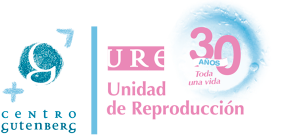Implantation bleeding: how can you tell?

When you go to an assisted reproduction clinic to receive help for something after trying on your own for months, or maybe even years, there are many new concepts that you’ll add to your vocabulary. That’s why at our fertility clinic in Spain we want to help you understand these terms that are probably not familiar to you, or maybe you’ve heard of them before but you’re not quite sure what they mean.
Once you’ve received a diagnosis at your first fertility consultation with us, with all of the basic tests we request to complete the fertility evaluation, the doctor will tell you which treatment or assisted reproduction technique is ideal in your particular case. This is generally artificial insemination (AI), or in vitro fertilisation (IVF).
The first stage of an in vitro fertilisation treatment normally starts with the ovarian stimulation, which tends to be mild in cases of artificial insemination and a little stronger for in vitro fertilisation. The ideal scenario in IVF treatment is to be able to obtain between 12 and 15 eggs during the egg retrieval process. These eggs will then be inseminated in the laboratory (generally using the ICSI technique).
After a few days of embryo development, one of the most important moments of your treatment will arrive: the embryo transfer. The transfer is normally performed on day five of embryo development, at blastocyst stage, and involves placing the best embryo, selected by our embryologists, into the uterine cavity. If possible we will freeze any additional, viable embryos.
What is embryo implantation?
Embryo implantation is the molecular biological process through which an embryo attaches to or invades the endometrium, which is the tissue that covers the female’s uterine cavity.
Once an embryo has implanted it will generally continue to develop there for the next nine months of pregnancy. In order for an embryo to correctly implant there must first be coordinated communication between a viable embryo and an endometrium that is receptive to implantation.
When does embryo implantation take place?
Once an egg has been fertilised by a spermatozoid in the outer third of the Fallopian tube, the early embryo embarks on a process of cell division and transport through the Fallopian tube towards the uterine cavity where it will arrive after developing for three or four days.
Embryo implantation begins on the sixth day of development and finishes around the thirteenth day. The exact moment at which this process should or can begin is known as the “implantation window”, and it starts five to seven days after ovulation took place.
This means that in a cycle of artificial insemination implantation will begin approximately 7 days after the intrauterine insemination procedure was performed. In cycles of in vitro fertilisation, however, implantation will start about 7 days after the egg retrieval procedure, or the day following the embryo transfer (if the embryo was transferred on day 5 of development).
What is implantation bleeding?
Keeping in mind all of the above, implantation bleeding is the term used to describe light bleeding that can happen a few days after embryo implantation has taken place. This occurs in approximately three out of every ten women.
There is a reason why implantation bleeding happens: in order for an embryo to continue developing properly it must start receiving nutrients from the mother’s body. For this to occur, the embryo needs to communicate with the mother’s endometrium, and this embryo-maternal communication may cause certain blood vessels in the endometrium to break.
This process leads to the formation of new blood vessels which make it possible for the embryo to obtain everything it needs during the early stages of development. This is what may cause something we call implantation bleeding.
Like we said before, this bleeding from the vagina doesn’t always happen. And it also doesn’t look exactly the same for every female. In some women it may almost go unnoticed, whereas in other cases it could seem more like a period. The important thing is to know how to distinguish one from the other in order to avoid a scare.
How to tell the difference between implantation bleeding and your period?
Being able to tell the difference between implantation bleeding and a period is important as it usually causes future moms to worry unnecessarily when it happens.
That’s why you need to be aware that this bleeding is generally less intense than during a period. It’s normally brown or light pink in colour and its duration doesn’t follow any one pattern: it can be a stain that you notice just once, or it can last for several hours.
On occasion it can carry on for several days like light or sporadic spotting, but it won’t be like a period.
What should you do if you have implantation bleeding?
In the event that you experience bleeding, at URE Centro Gutenberg we always recommend contacting our medical team so that we can help you to determine the cause and then tell you what the most appropriate course of action will be in your case.
As you’ve read, this isn’t something to be worried about but it’s good to know what to be aware of and to understand that many future moms become concerned when they experience this. For this reason, don’t hesitate to contact us if this happens to you and we’ll do everything possible to help you.

